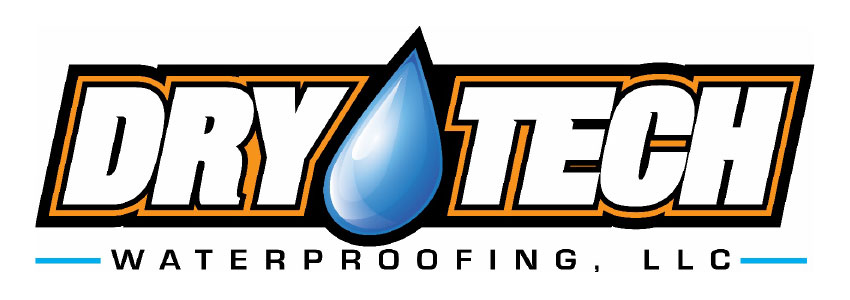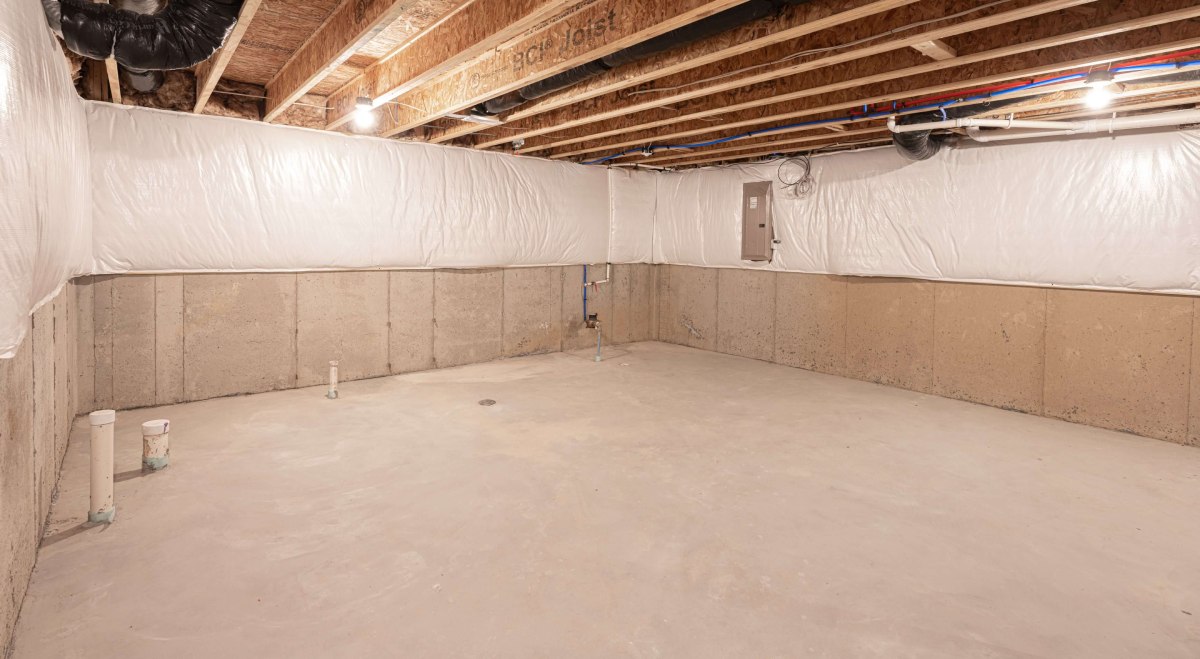
21 Apr Basement Waterproofing Repair and Preventative Processes
Standing water, condensation buildup, or dampness can be the cause of a variety of damage to your home – from mildew and mold growth to expensive structural problems like sinking foundations. Understanding how moisture works its way in and out of your home is the first step towards identifying and addressing any issues with wet basements, crawl spaces, or other hidden areas that are difficult to access.
The importance of waterproofing cannot be emphasized enough when it comes to basement construction as well as crawl space repair. A properly finished basement will help keep humidity at bay, which reduces the likelihood of rot and drywall cracking. If the waterproofing process is not done right, however, the opposite effect occurs. This type of condition is common in homes built before modern waterproofing techniques were used. While this issue may seem minor, improperly waterproofed walls can lead to costly structural problems down the road.
How To Determine If Your Basement Needs Repairs
If you see signs that your basement has become saturated, it’s essential to know what causes this condition. While there should never be stagnant water anywhere in your basement for long periods, if you notice water pooling near pipes, electrical outlets, windows, doors, walls, and other places, you need to address these areas as soon as possible. This could indicate cracks in exterior foundation walls or improper installation of drainage systems.
It could also mean that water is entering through an improperly sealed window, door, or crawlspace access. The most common water intrusion into basements is around plumbing fixtures such as sinks, toilets, tub/shower combinations, and any fixture where the drain line runs under concrete slab flooring.
If you suspect that your basement needs repair, you should call professionals who specialize in waterproofing basements or remediation (waterproofing & restoration) and let them inspect your structure for leaks. Once they determine the source of the leak, they will offer a comprehensive plan for fixing it and sealing your entire leaky basement and crawl space completely.
Basement Waterproofing Solutions
No matter how strong a basement wall appears, flooding still poses a threat. Although homeowners can take several precautions to minimize this risk, it is impossible to eliminate all risks of leakage. However, the following solutions can reduce the chances that a flood damages your property.
Basement Drainage Systems
One of the best ways to prevent flooding from occurring within your home is by installing a proper drainage system. To prevent water from accumulating in your basement, you must install a system that allows excess water to flow away from the building. Drain lines should be placed directly beneath any exterior or interior walls so that excess rainwater flows away from the building instead of collecting on top of floors or walls.
A well-designed linear drainage system addresses both soil absorption and runoff control. In addition, it allows for easy cleaning because debris does not build up against the bottom of the pipe.
French drains
A French drain is a popular basement waterproofing solution because it effectively prevents water from seeping into the ground below your house. French drains are designed to divert water away from the foundation by creating a trench along the perimeter of the area above ground level. French drains use porous material like stone or gravel as well as various types of vegetation to absorb moisture from the surrounding soil.
They can be installed quickly and are relatively inexpensive compared to other options. You will have to pay close attention to the area you choose to install a French drain by ensuring that any trees or shrubs are removed prior to excavation.
Interior vs. exterior drainage system
Interior and exterior drainage systems differ in their design and function. An interior drainage system evacuates water from the foundation, while an exterior drainage system prevents water from reaching the foundation.
Interior drainage systems are installed inside the basement walls. They are typically made out of plastic pipes with perforated bottoms that allow excess water to escape along the foundation walls to facilitate the use of French drains. These systems are usually less expensive than exterior drainage systems since they do not require digging big trenches or excavating soil.
Interior systems also provide better protection against water damage if there is a problem with the exterior drainage system. For example, if the exterior drainage system fails, then the interior drainage system can continue to function normally.
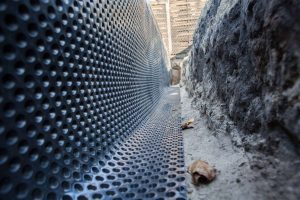
Exterior drainage systems are installed outside the basement walls. They consist of large trenches that collect and channel water away from the foundation. The size of these trenches depends upon the amount of rainfall expected during the year. If you live in an area with heavy rainfall, you may need to install larger basements to accommodate the volume of water.
Exterior drainage systems provide excellent protection against flood damage, but they have some drawbacks. For instance, they are much more difficult to install; therefore, they are usually significantly more expensive than interior drainage systems.
If your property is prone to flooding, then you need to invest in either type of system, depending on how often you expect to experience flooding. At Dry Tech, we recommend using both exterior and interior underground drainage systems since this combination provides the best protection possible against both surface and subsurface water intrusion. If you want us to install one or both drainage systems for you, please call Dry Tech at (865) 410-1077 for your free estimate today!
Sump Pumps
Another common method of minimizing flooding is the installation of sump pumps. Sump pumps remove water from the lowest part of the foundation where it accumulates and direct it through pipes that lead to your exterior drainage system. This helps prevent the buildup of water around the base of the structure and keeps your basement dry.
Most municipalities require that any new building must include a sump pump. It’s important to note that sump pumps should never be used as a primary means of removing water from the home. Sump pumps only work when the water levels rise high enough to activate them. They are meant to keep water from accumulating near the foundation so that it doesn’t cause damage.
Your interior drainage system can be connected with a sump pump system. This creates a continuous path for draining water away from the foundation while allowing the entire home’s plumbing and electrical systems to operate normally.
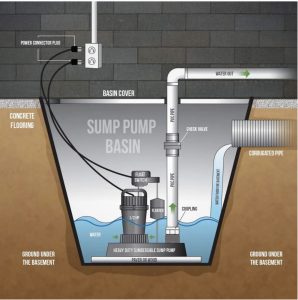
How Does a Sump Pump work?
A sump is a pit located beneath a building that collects water runoff. This pit is the basin where your sump pump is installed.
When rainwater flows into the house, it enters the pit via drainage pipes. The rainwater falls into the pit and begins to accumulate. When the water level rises over a certain height, your sump pump is activated and automatically pumps excess water into underground pipes, which drain to the drainage system.
A basement sump pump is one of the most popular methods of controlling basement and crawl space moisture issues at home. Sump pumps have been proven time and time again to help protect homes and their occupants against water damage caused by excessive rainfalls. An adequately maintained sump pump will effectively reduce the chances of flooding inside a house.
It is imperative that you know how to buy a sump pump that suits your needs. Sump pumps come in different types and capacities, and it can be confusing knowing what kind you should install. At DryTech, we have decades of experience and know all about wet basement repair. We can guide you through the process of choosing the right sump pump for your flooded basement. Call us now at (865) 410-1077 to discuss your needs and receive a free consultation.
Basement Sealing Floors and Walls
While a good drainage system will help minimize or prevent basement leakage problems, this alone isn’t going to guarantee that the basement won’t leak. If there is a crack or hole in the concrete floor slab, then even a well-designed drainage system might not be able to stop water from entering the basement. Hydrostatic pressure can build up behind walls and floors, forcing water back up through cracks and holes until they reach a weak point, such as a nail hole.
The best way to prevent leaks is to seal the cracks and holes in the concrete floor slab. These cracks and holes are typically found on the perimeter of the basement and are often caused by the soil settling under the foundation. Cracks and holes can also occur due to faulty concrete mixing equipment, improper construction techniques, or construction defects.
Sealants are commonly applied between all layers of insulation, concrete, brick, or other porous materials such as cinder blocks. On top of that, you’ll need to apply an additional layer of waterproof membrane to ensure that the sealant stays put. A waterproof membrane acts like a second skin protecting the subfloor from moisture.
A waterproof membrane is a thin sheet of plastic material that goes over the top of the concrete floor slab. The membrane seals out all liquids such as water, oil, and gas. It prevents any moisture from penetrating the concrete or basement floor.
If you suspect that there is a problem with the integrity of the concrete floor slab, contact us today! We can inspect your property and provide you with a free estimate.
Stabilizing Bowed Walls
One of the most common causes of cracked walls is bowing. Bowing occurs when the weight of a structure presses down on a wall causing it to bow outward. As a result, the wall may begin to crack or split. If you notice cracks forming along the exterior surface of your walls, you should call a professional immediately.
Cracking in interior walls can be more difficult to spot. You may notice some shifting around furniture or other items within your home. This could indicate that a wall is beginning to buckle inward. If you see any changes to the layout of the rooms in your home, it’s probably time for the walls to be checked.
Bowed walls are often caused by uneven settlement. The two main factors contributing to the uneven settlement include: (1) the type of soils beneath the building; and (2) any settling that occurred before construction.
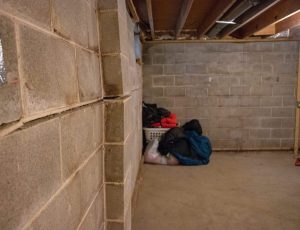
How to know if you have bowed walls and how to fix it
You’ve likely noticed if your house seems to lean towards one side. There’s a good chance this comes from bowing walls. Bowing can happen if your foundation isn’t level or your soil is too soft. If your home settles unevenly, it will cause cracks that eventually end up looking like bowed walls. Because of this, you should get these walls inspected by a structural engineer. They will take precise measurements of the location of the cracks and give you an idea of what steps you should take to correct any issues that might be present.
Bowed walls can be repaired either by straightening the walls or using stabilization products to stabilize them. Straightening a bowing wall means reinforcing it so that the curve returns to a straight line. By installing wall anchors into the existing cracks, you create new anchor points that can support a heavy load and helps restore the original shape of the wall.
Stabilizing the bowing wall involves creating a barrier against which the wall can expand without cracking or breaking apart. For instance, one option is to install carbon fiber that keeps the wall stable until it has been stabilized permanently. Carbon fiber strips are applied to the wall to stabilize it and prevent further bowing. As the wall expands and contracts during temperature fluctuations, the carbon fibers keep the wall rigidly attached to the backing fabric.
DryTech Can Help You Prevent Water Damage or Solve Your Wet Basement Problems
Basements can become very humid and damp due to condensation forming inside wall voids that run throughout your home. Moisture can accumulate because of poor drainage, allowing water to remain trapped below the ground. Basement water buildup can lead to rot, mold, mildew, and even structural damage, which is why it’s so important to have your wet basement waterproofed properly.
Most modern homes have a built-in waterproofing system to protect their basements. These basement systems are designed to stop water from entering through the basement walls. Even so, water can still seep through small cracks and spaces between the exterior of the basement and its subsoil. To ensure your basement stays dry, we recommend addressing all the areas where moisture may collect in your home, including around doorways, under windows, sloped roofs, and other areas that provide easy access for water outside of the structure.
At Dry Tech Waterproofing, we offer several different types of basement waterproofing and foundation repair options for our customers, depending on the size and condition of your home. We can inspect your basement at no cost and make recommendations based on your situation. Once we’ve determined how much work needs to be done, we’ll talk with you about how long it takes to complete the project. Our goal is to develop proven solutions that work best for your budget, schedule, and unique circumstances.
If you want to learn more about our basement & crawl space waterproofing services, call us today at (865) 410-1077 or contact us online. Speak with our skilled waterproofing specialists in Knoxville, TN and see how you can minimize the risk of damage to your home.
